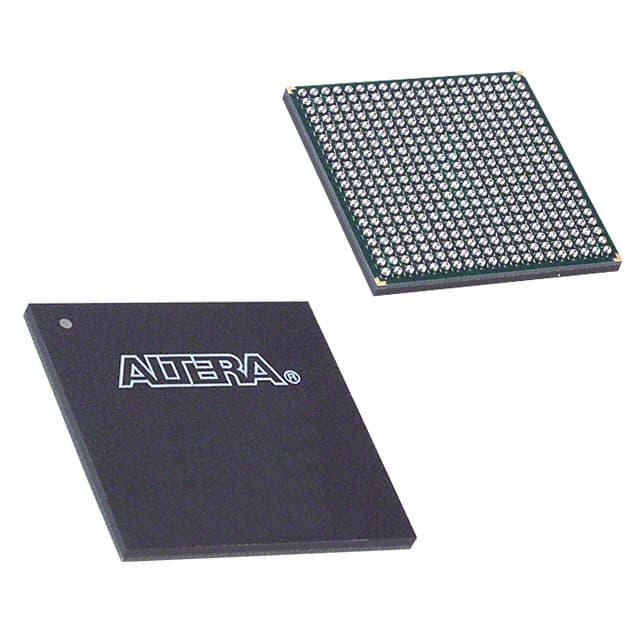EP1C20F400C6N
Product Overview
Category
EP1C20F400C6N belongs to the category of programmable logic devices (PLDs).
Use
This product is primarily used in digital circuit design and implementation. It provides a flexible and customizable solution for various applications.
Characteristics
- Programmable: EP1C20F400C6N can be programmed to perform specific functions according to the user's requirements.
- High-performance: It offers fast processing speeds and efficient operation.
- Versatile: This PLD supports a wide range of applications due to its programmability.
- Compact: EP1C20F400C6N comes in a small package, making it suitable for space-constrained designs.
Package
The EP1C20F400C6N is available in a compact package that ensures easy integration into electronic circuits.
Essence
The essence of EP1C20F400C6N lies in its ability to provide a customizable and high-performance solution for digital circuit design.
Packaging/Quantity
This product is typically packaged in reels or trays, depending on the manufacturer's specifications. The quantity per package may vary, but it is commonly available in bulk quantities.
Specifications
- Device Type: Programmable Logic Device (PLD)
- Family: EP1C20
- Number of Logic Elements: 20,000
- Number of I/O Pins: 400
- Operating Voltage: 3.3V
- Speed Grade: C6
- Package Type: BGA (Ball Grid Array)
Detailed Pin Configuration
The EP1C20F400C6N has a total of 400 I/O pins, which are organized into different banks. Each bank consists of multiple pins and serves specific functions within the device.
For a detailed pin configuration diagram, please refer to the datasheet provided by the manufacturer.
Functional Features
- High-speed operation: EP1C20F400C6N offers fast processing speeds, enabling efficient execution of complex digital circuits.
- Flexible I/O configuration: The device provides a wide range of I/O pins, allowing for versatile connectivity options.
- Programmability: Users can program EP1C20F400C6N to perform specific functions, making it adaptable to various applications.
- Embedded memory: This PLD includes embedded memory blocks that can be used for data storage or as lookup tables.
Advantages and Disadvantages
Advantages
- Customizability: EP1C20F400C6N allows users to tailor its functionality to meet specific requirements.
- Compact size: The small package size makes it suitable for designs with limited space.
- High-performance: The device offers fast processing speeds and efficient operation.
Disadvantages
- Learning curve: Utilizing the full potential of EP1C20F400C6N may require a learning curve due to its programmable nature.
- Limited I/O pins: Although it provides a significant number of I/O pins, some applications may require more extensive connectivity options.
Working Principles
EP1C20F400C6N operates based on the principles of programmable logic. It consists of configurable logic blocks (CLBs), interconnect resources, and embedded memory blocks. The CLBs can be programmed to implement desired logic functions, while the interconnect resources facilitate communication between different components within the device. The embedded memory blocks provide additional storage capacity for data or lookup tables.
The device is programmed using hardware description languages (HDL) or specialized software tools provided by the manufacturer. Once programmed, EP1C20F400C6N executes the specified logic functions, enabling the desired behavior in the digital circuit.
Detailed Application Field Plans
EP1C20F400C6N finds applications in various fields, including but not limited to: - Telecommunications: It can be used in the design of communication systems, such as routers and switches. - Industrial automation: EP1C20F400C6N enables the implementation of control systems for industrial processes. - Automotive electronics: This PLD can be utilized in automotive applications, such as engine control units or advanced driver-assistance systems (ADAS). - Consumer electronics: It can be integrated into consumer electronic devices, providing customized functionality.
Detailed and Complete Alternative Models
- EP1C12F256C8N
- EP1C3T100C8N
- EP1C6Q240C8N
- EP1C20F324C7N
- EP1C20F484C7N
These alternative models offer similar functionalities to EP1C20F400C6N but may differ in terms of logic capacity, I/O pins, or package type. Users should consider their specific requirements when selecting an alternative model.
*Note: The content provided above is a general outline and may require further expansion to reach the desired word count of
قم بإدراج 10 أسئلة وإجابات شائعة تتعلق بتطبيق EP1C20F400C6N في الحلول التقنية
Sure! Here are 10 common questions and answers related to the application of EP1C20F400C6N in technical solutions:
Q1: What is EP1C20F400C6N? A1: EP1C20F400C6N is a specific model of Field-Programmable Gate Array (FPGA) manufactured by Intel.
Q2: What are the key features of EP1C20F400C6N? A2: Some key features of EP1C20F400C6N include 20,060 logic elements, 288 embedded memory blocks, and support for various I/O standards.
Q3: What are the typical applications of EP1C20F400C6N? A3: EP1C20F400C6N is commonly used in applications such as digital signal processing, industrial automation, telecommunications, and high-performance computing.
Q4: How can EP1C20F400C6N be programmed? A4: EP1C20F400C6N can be programmed using Hardware Description Languages (HDLs) like VHDL or Verilog, which describe the desired functionality of the FPGA.
Q5: Can EP1C20F400C6N be reprogrammed after initial programming? A5: Yes, EP1C20F400C6N is a reprogrammable FPGA, allowing for flexibility in design iterations and updates.
Q6: What tools are available for designing with EP1C20F400C6N? A6: Intel provides Quartus Prime software, which includes tools for designing, simulating, and programming EP1C20F400C6N FPGAs.
Q7: Does EP1C20F400C6N support communication interfaces? A7: Yes, EP1C20F400C6N supports various communication interfaces such as UART, SPI, I2C, and Ethernet.
Q8: Can EP1C20F400C6N interface with external memory devices? A8: Yes, EP1C20F400C6N has dedicated pins and support for interfacing with external memory devices like DDR SDRAM or Flash memory.
Q9: What is the power supply requirement for EP1C20F400C6N? A9: EP1C20F400C6N typically operates at a voltage range of 1.15V to 1.25V, with additional voltage requirements for I/O banks.
Q10: Are there any development boards available for prototyping with EP1C20F400C6N? A10: Yes, Intel offers development boards like the Cyclone II FPGA Starter Kit, which includes EP1C20F400C6N and provides a platform for prototyping and testing designs.
Please note that these answers are general and may vary depending on specific design requirements and application scenarios.


